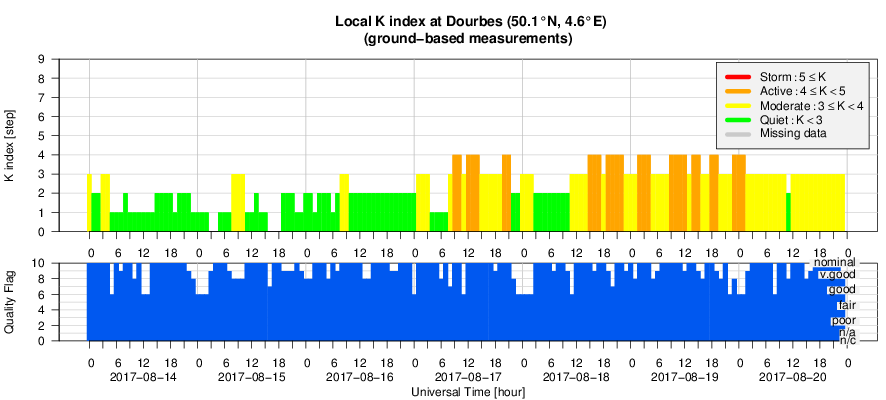- Table of Content
- 1.Solar Eclipse ...
- 2.Modelling the ...
- 3.PROBA2 Observa...
- 4.Review of sola...
- 5.Space Weather ...
- 6.Noticeable Sol...
- 7.The Internatio...
- 8.Geomagnetic Ob...
- 9.Review of iono...
- 10.Future Events
2. Modelling the Solar Wind
3. PROBA2 Observations (14 Aug 2017 - 20 Aug 2017)
4. Review of solar and geomagnetic activity
5. Space Weather Briefing
6. Noticeable Solar Events (14 Aug 2017 - 20 Aug 2017)
7. The International Sunspot Number (14 Aug 2017 - 20 Aug 2017
8. Geomagnetic Observations at Dourbes (14 Aug 2017 - 20 Aug 2017)
9. Review of ionospheric activity (14 Aug 2017 - 20 Aug 2017)
10. Future Events
Solar Eclipse - PROBA2 did it
PROBA2 saw the solar eclipse from its 750 km-high seat in space. PROBA2 captured this EUV-image with the moon partly covering the sun.
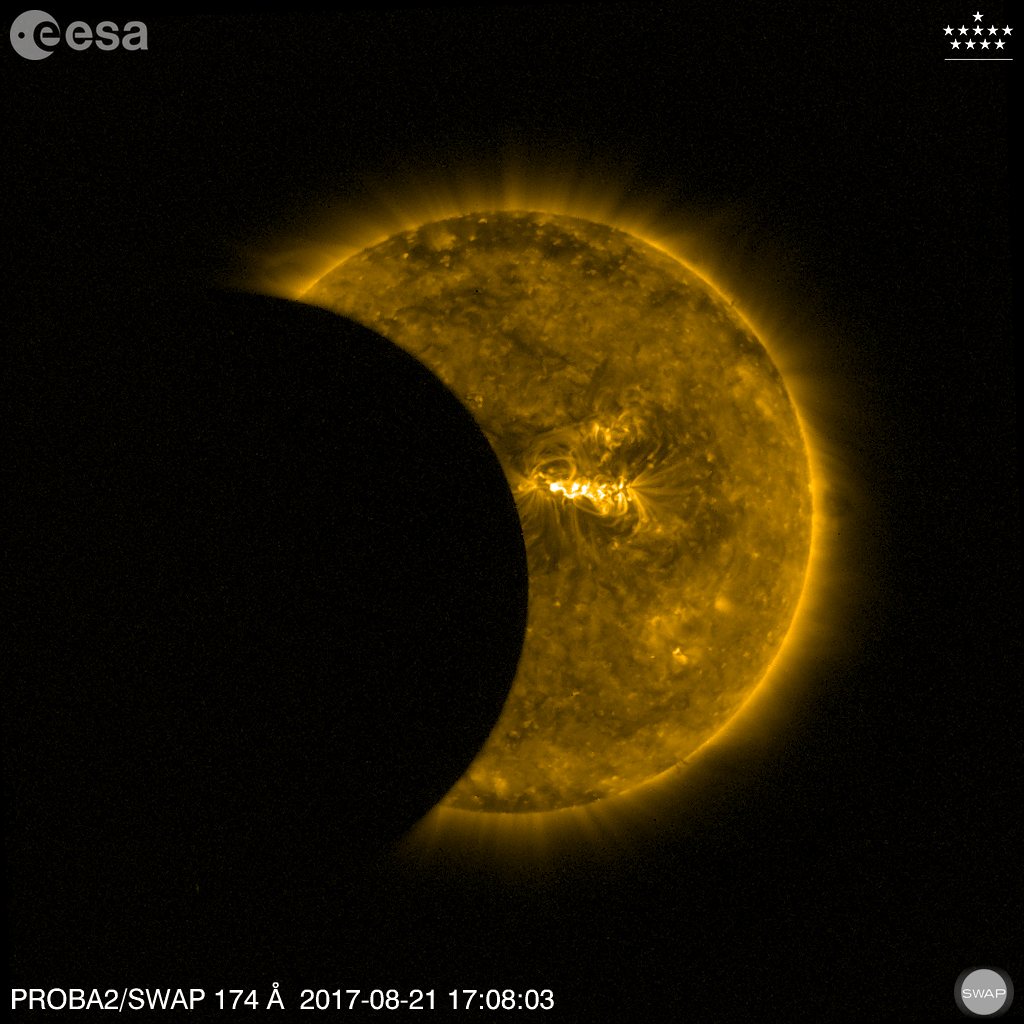
The telescope SWAP onboard of the micro-satellite PROBA2 recorded the passing of the moon in front of the sun. This is a still image taken at 17:08UT. It is an EUV-image showing part of the solar atmosphere and a very bright region in the middle of the solar disk.
Check the PROBA2 website for movies and more pictures: http://proba2.oma.be/eclipse-August-2017
Modelling the Solar Wind
At a 'Talk Cosmic to me' event - The Sun, more than a gigantic tan factory, check https://www.facebook.com/talkcosmictome/
somebody draw an accurate and detailed model of the solar corona and the solar wind off the top of his head, just like that. This research clearly shows that the Sun has a hidden personality. Do you see it?
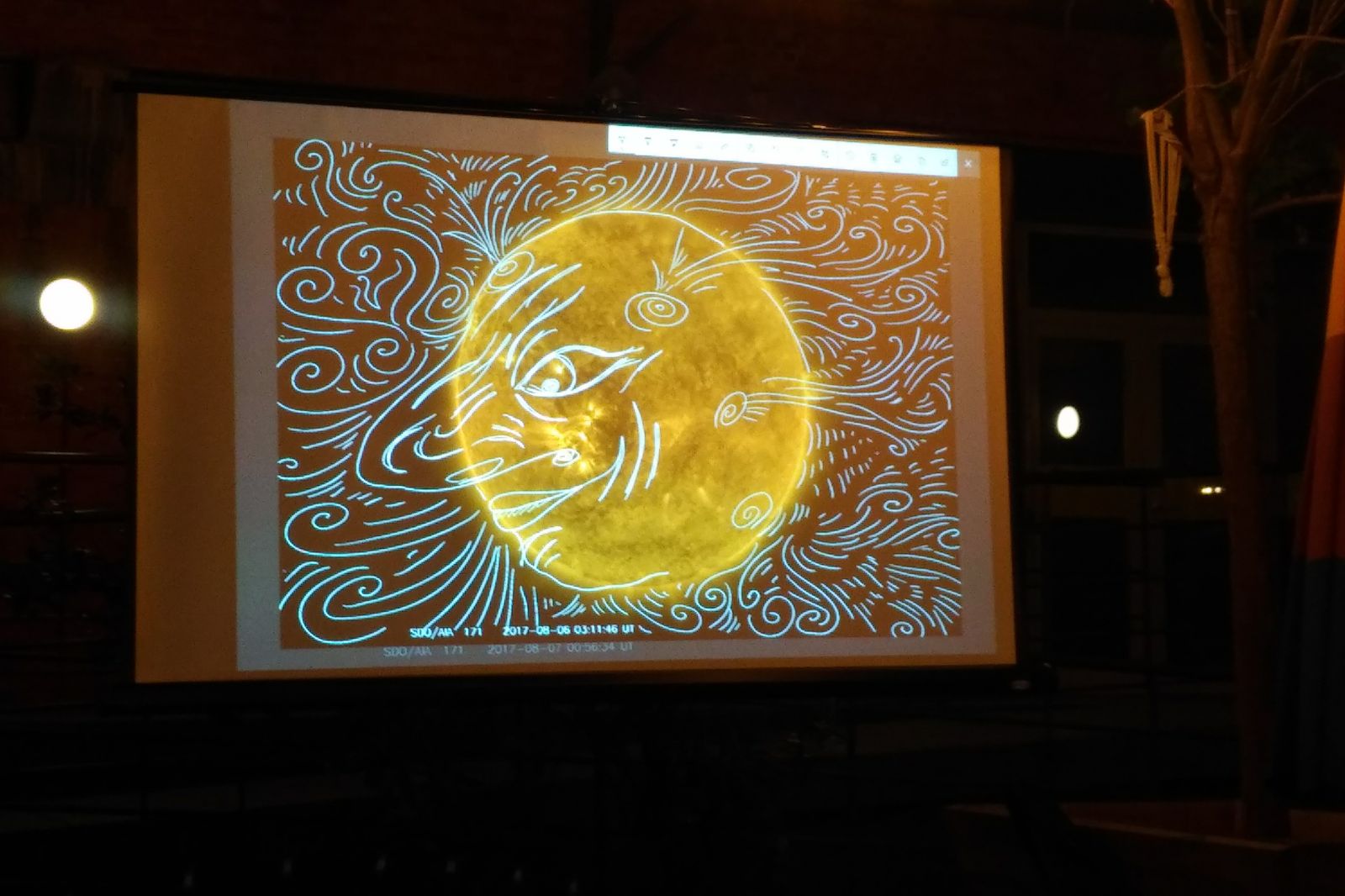
PROBA2 Observations (14 Aug 2017 - 20 Aug 2017)
Solar Activity
Solar flare activity fluctuated between very low and moderate during the week.
In order to view the activity of this week in more detail, we suggest to go to the following website from which all the daily (normal and difference) movies can be accessed: http://proba2.oma.be/ssa
This page also lists the recorded flaring events.
A weekly overview movie can be found here (SWAP week 386):
http://proba2.oma.be/swap/data/mpg/movies/weekly_movies/weekly_movie_2017_08_14.mp4
Details about some of this week's events, can be found further below.
If any of the linked movies are unavailable they can be found in the P2SC movie repository here:
http://proba2.oma.be/swap/data/mpg/movies/
Wednesday Aug 16

A prominence was observed by SWAP in the north east quadrant of the Sun shown in the SWAP image above at 17:15 UT on 2017-Aug-16
Find a movie of the event here (SWAP movie):
http://proba2.oma.be/swap/movies/20170816_swap_movie.mp4
Saturday Aug 19

NOAA active region 2671 produced multiple c-class flares over the week. The largest flare it produced was a C7.0 flare, which occurred on 2017-Aug-19, and is shown in the centre of the solar disk in the SWAP image above at 21:51 UT.
Find a movie of the event here (SWAP movie):
http://proba2.oma.be/swap/movies/20170819_swap_movie.mp4
Sunday Aug 20

The largest flare of the week was an M-class (M1.1) flare on 2017-Aug-20 from NOAA AR 2672, shown on the eastern limb of the Sun in the SWAP image above at 03:34 UT.
Find a movie of the event here (SWAP movie):
http://proba2.oma.be/swap/movies/20170820_swap_movie.mp4
Review of solar and geomagnetic activity
SOLAR ACTIVITY
The week started with NOAA AR 2671 rotating into view and producing numerous C-class flares. The region grew in size and complexity (evolved into beta gamma delta configuration by August 17, and went back to beta gamma on the day after), but did not produce any flare between 16 and 18 August. On August 18, NOAA AR 2672 (beta magnetic field configuration) started to produce C-class flares as it rotated into view. On August 20 it produced an M1.1 flare peaking at 01:52 UT, this was the strongest flare of the week.
No Earth-directed CMEs were observed.
GEOMAGNETIC ACTIVITY
Geomagnetic conditions were quiet until August 17 when the fast speed stream from a positive polarity coronal hole (in the northern hemisphere) arrived to the Earth and produced K up to 4 locally at Dourbes, whereas at planetary levels Kp reached 5. The speed reached 780 km/s with interplanetary magnetic field magnitudes up to 13 nT. The disturbed geomagnetic conditions lasted until the end of the week.
Space Weather Briefing
The Monday Space Weather Briefing presented by the forecaster on duty from Aug 14 to 20. It reflects in images and graphs what is written in the Solar and Geomagnetic Activity report.
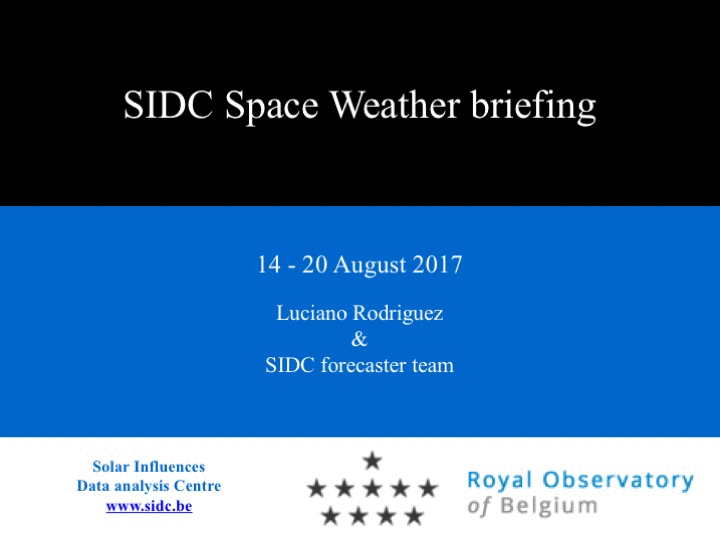
The movie icons refer to the following links:
movie 1: http://www.stce.be/movies/20170821_hmi.mp4
movie 2: http://www.stce.be/movies/20170821_CME-Aug16.mp4
movie 3: http://www.stce.be/movies/20170821_CME-Aug18.mp4
Noticeable Solar Events (14 Aug 2017 - 20 Aug 2017)
| DAY | BEGIN | MAX | END | LOC | XRAY | OP | 10CM | TYPE | Cat | NOAA |
| 20 | 0136 | 0152 | 0203 | M1.1 | 2672 |
| LOC: approximate heliographic location | TYPE: radio burst type |
| XRAY: X-ray flare class | Cat: Catania sunspot group number |
| OP: optical flare class | NOAA: NOAA active region number |
| 10CM: peak 10 cm radio flux |
The International Sunspot Number (14 Aug 2017 - 20 Aug 2017
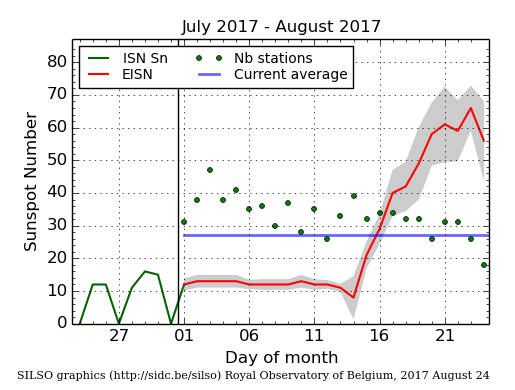
The daily Estimated International Sunspot Number (EISN, red curve with shaded error) derived by a simplified method from real-time data from the worldwide SILSO network. It extends the official Sunspot Number from the full processing of the preceding month (green line). The plot shows the last 30 days (about one solar rotation). The horizontal blue line shows the current monthly average, while the green dots give the number of stations included in the calculation of the EISN for each day.
Review of ionospheric activity (14 Aug 2017 - 20 Aug 2017)
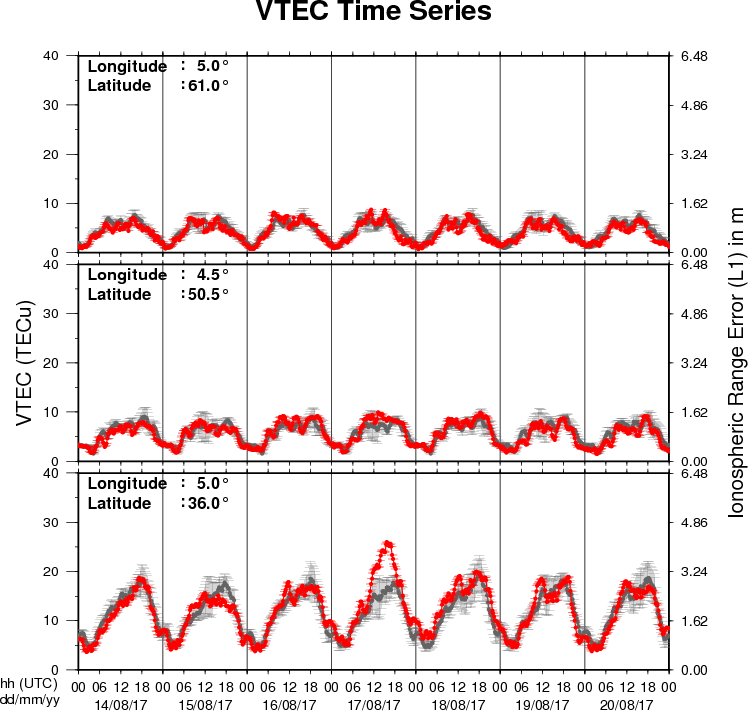
The figure shows the time evolution of the Vertical Total Electron Content (VTEC) (in red) during the last week at three locations:
a) in the northern part of Europe(N61°, 5°E)
b) above Brussels(N50.5°, 4.5°E)
c) in the southern part of Europe(N36°, 5°E)
This figure also shows (in grey) the normal ionospheric behaviour expected based on the median VTEC from the 15 previous days.
The VTEC is expressed in TECu (with TECu=10^16 electrons per square meter) and is directly related to the signal propagation delay due to the ionosphere (in figure: delay on GPS L1 frequency).
The Sun's radiation ionizes the Earth's upper atmosphere, the ionosphere, located from about 60km to 1000km above the Earth's surface.The ionization process in the ionosphere produces ions and free electrons. These electrons perturb the propagation of the GNSS (Global Navigation Satellite System) signals by inducing a so-called ionospheric delay.
See http://stce.be/newsletter/GNSS_final.pdf for some more explanations ; for detailed information, see http://gnss.be/ionosphere_tutorial.php
Future Events
For more details, see http://www.spaceweather.eu/en/event/future
2017 Joint IAPSO-IAMAS-IAGA Assembly in Cape Town, South Africa
Start : 2017-08-27 - End : 2017-09-01
The Joint IAPSO-IAMAS-IAGA Assembly, endorsed by the University
of Cape Town and the South African Department of Science and
Technology, will take place from 27 August to 1 September 2017 at
the Cape Town International Convention Centre (CTICC). Several IAGA
and IAMAS sessions are of Space Weather interests as well as the
joint session 'Space Weather throughout the Solar System: Bringing
Data and Models together'.
Website:
http://iapso-iamas-iaga2017.com/index.php
Workshops on Radiation Monitoring for the International Space Station in Torino, Italy
Start : 2017-09-05 - End : 2017-09-07
The Workshop on Radiation Monitoring for the International Space
Station is an annual meeting to discuss the scientific definition
of an adequate radiation monitoring package and its use by the
scientific community on the ISS. Types of instruments and research
topics need to be defined in order to optimise the radiation safety
of the ISS crew.
Website: http://wrmiss.org/
International Workshop on Solar, Heliospheric & Magnetospheric Radioastronomy in Meudon, France
Start : 2017-11-06 - End : 2017-11-10
Jean-Louis Steinbeg has been one of the major pioneers in
radioastronomy. Co-founder of the Nançay Observatory, he
has actively participated to, an inspired a large number of radio
instruments on many international space missions. Jean-Louis
Steinberg is the founder of the Space Radioastronomy laboratory of
the Paris Observatory in 1963. Later on, this laboratory widened
its science interests and became the DESPA (1971) and then the
current LESIA (2002) which is one of the major space sciences
laboratories in France. The aim of this workshop is to cover the
science topics which Jean-Louis Steinberg has promoted during his
career, focusing on Solar, Heliospheric & Magnetospheric
radioastronomy & physics. This will be done by covering both
observations from either ground facilities (NDA, RH, LOFAR, Artemis
etc ...) or space missions (ISSEE, Ulysses, WIND, CLUSTER, STEREO,
CASSINI, JUNO etc ...) and models/theories. A series of invited
talks is also foreseen to cover the new developments in the
discipline which may come with the future facilities such as Solar
Orbiter, Solar Probe Plus, JUICE, JUNO, LOFAR+, SKA etc ....
This workshop will also be the opportunity to remember both the
extraordinary personal & professional lifes of Jean-Louis
Steinberg especially for new generation of scientists. At the
occasion of this workshop it is also expected that the Building 16
(historical Space Sciences building) on the Meudon campus will be
renamed "Building Jean-Louis Steinberg".
Website:
https://jlsworkshop.sciencesconf.org/
European Space Weather Week 14
Start : 2017-11-27 - End : 2017-12-01
The ESWW is the main annual event in the European Space Weather
calendar. It is the European forum for Space Weather as proven by
the high attendance to the past editions. The agenda will be
composed of plenary/parallel sessions, working meetings and
dedicated events for service end-users. The ESWW will again adopt
the central aim of bringing together the diverse groups in Europe
working on different aspects of Space Weather.
Website:
http://www.stce.be/esww14/
